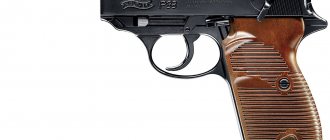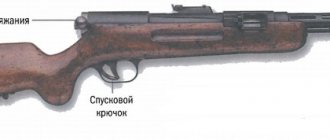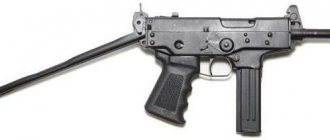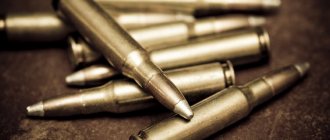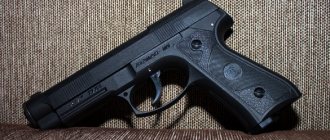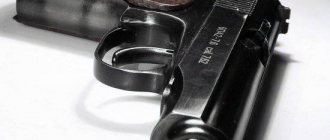This article is about the submachine gun. For the paleontological zone designated MP 18, see Paleogene Mammal Zone.
Type of submachine gun
| MP 18 | |
| Bergmann MP 18 | |
| Type | Submachine gun |
| Place of origin | German Empire |
| Service history | |
| In service | 1918–1945 (Germany) |
| Used | See Users |
| Wars | First World War German Revolution Irish Civil War Rif War Chaco War Spanish Civil War Second Sino-Japanese War Chinese Civil War German-Czechoslovak War Second World War Malayan Emergency |
| Production history | |
| Designer | Hugo Schmeisser |
| Designed by | 1916 1928 (MP 28/II) |
| Manufacturer | Bergmann Waffenfabrik Qingdao Iron and Steel Works SIG (SIG M1920) |
| Produced | 1918–1920s 1928 - early 1940s (MP 28/II) |
| No. built | Less than 30,000 |
| Characteristics | |
| Weight | 4.18 kg (9.2 lb) 4.0 kg (8.8 lb) (MP 28/II) |
| Length | 832 mm (32.8 in) |
| Barrel length | 200 mm (7.9 in) |
| Cartridge | 9 × 19 mm Parabellum 7.63 × 25 mm Mauser (Export) 7.65 × 21 mm Parabellum (Export) 9 × 23 mm Largo (Export) (MP 28 / II) 9 × 25 mm Mauser (Export) (MP 28 / II) .45 ACP (Export) (MP 28/II) |
| Action | blowback open bolt |
| Rate of fire | ~350-500 rounds/min 550-600 rounds/min (MP 28/II) |
| starting speed | 380 m/s (1,247 ft/s) |
| Feeding system | 20-round detachable box magazine (Prototypes, post WWI, MP 28/II) 30-round detachable box magazine (post WWI) 32-round detachable box magazine (MP 28/II) 32-round detachable TM 08 drum magazine (World War I) 50-round detachable box magazine (MP 28/II, from Lanchester); |
B MP 18
manufactured by Theodor Bergmann
Abteilung Waffenbau
was the first submachine gun used in combat.
It was adopted by the German Army in 1918 during World War I as the main weapon of the Sturmtruppen
, assault teams specialized in trench warfare. Although production of the MP 18 ended in the 1920s, its design formed the basis for most submachine guns produced between 1920 and 1960.[1]
Story
Trademark of Theodor Bergmann
What became known as the "submachine gun" originated in the early 20th century and developed from the concepts of fire and movement and infiltration tactics specifically for the task of clearing trenches of enemy soldiers, an environment in which confrontations were unlikely to occur outside range of several feet.
In 1915, the German Spandau Rifle Test Commission decided to develop a new weapon for trench warfare. An attempt to modify existing semi-automatic pistols, particularly the Luger and C96 Mauser, failed because accurate aimed fire in full-automatic mode was impossible due to their light weight and high rate of fire - 1,200 rounds per minute. The commission decided that a completely new type of weapon was needed. Hugo Schmeisser, working at Bergmann Waffenfabrik
was part of a team consisting of Theodor Bergmann and several other technicians.
They developed a new type of weapon to meet the requirements, which was designated Maschinenpistole
18/I
. It is unclear whether the "I" stands for the number 1 or the letter I, although its successor, the MP28, was designated Maschinenpistole
28/II
(suggesting the former).
Full production began in early 1918.[2] Although technically this is not the world's first submachine gun, inferior to the double-barreled Italian. Villar-Perosa 1915, in modern use of the term MP 18 is considered the world's first submachine gun as the Villar Perosa was designed for use as a light machine gun on aircraft before it was adapted for infantry use as a single-barrel weapon to fire with shoulder (Beretta SMG) in late 1918
Service history
German soldier with MP 18 in northern France, 1918.
The MP 18 served in the final stages of the First World War in 1918, especially in the Kaiserschlacht
offensive Over 25,000 were produced until the Treaty of Versailles banned the production of military submachine guns in 1920.[3]
The MP 18 turned out to be an excellent weapon. Its concept has proven itself well in positional battles. The basic design directly influenced the design of later submachine guns and showed its superiority over the conventional infantry rifle in urban, mobile and guerrilla warfare. The MP 18 served in German police and paramilitary forces after the end of the war. Widely used in battles by Freikorps Von Epp
against the Spartak League in Bavaria and other
Freikorps
in Berlin, where its effectiveness in urban combat was demonstrated.
In all limited conflicts between 1920 and 1940, this new class of weapon was increasingly used, first in South America during the Chaco War,[4] then in Europe during the Spanish Civil War, and in China during the Warlord's Era[5] and the Japanese invasion where its use by well-trained Chinese troops was costly to the invaders, as in the Battle of Shanghai.[ citation needed
] It was also used during World War II by various partisans and resistance forces.[1]
Berlin 1919
As the treaty allowed the Weimar Republic. To preserve a small number of submachine guns for police use, several hundred MP 18.1s were modified to accept Schmeisser's original 20-round magazine design. This modification, carried out by Haenel Waffenfabrik, required the removal of the existing magazine well collar and its replacement with another. This weapon was stamped with the date "1920" on the receiver and magazine to show that it was a legitimate weapon belonging to the Weimar Republic and not a weapon returned during the war or a secret weapon.[ citation needed
]
Bergmann licensed the MP 18. 1 to SIG Switzerland; The Swiss made model was known as the SIG Bergmann 1920. It existed in .30 Luger and 7.63mm Mauser. The Bergmann MP 18.1 represents a milestone both in terms of weapons technology and war tactics. This paved the way for an entirely new class of weapon and spurred research into lighter, automatic firearms to be used by mobile forces. Its first direct competitors did not fight in World War I, but most saw service in all the limited conflicts that took place during the interwar period.
Evolution
French-made STA Modèle 1924 The
French, despite having moderate interest in this class of weaponry as they had developed and fielded many semi-automatic and automatic weapons, immediately began research based on captured MP 18s. The STA 1922 design was accepted and the 1924 MAS .
or
9 mm STA Modèle 1924
entered service and was used in colonial conflicts in Morocco.
About 1,000 of these rifles were produced, as well as captured ex-German MP 18s,[1] which saw limited service during World War II.[6] MP 18 made in Qing Tao, China, 1927.
The Chinese produced a modified MP 18 in Qing Tao with the help of Heinrich Vollmer. [ citation needed
]
MP 28 on top of MP 28 in Yoav Fortress (the description on the community wiki says MP28, even though it is called MP 18, which probably comes from MP 28 being an improved MP18), which was named after Operation Yoav
B MP 28
was produced by K. G. Haenel under the direction of Hugo Schmeisser.
The MP 28 was manufactured under license by Etablissements Pieper in Belgium.[7] This was copied by the Second Spanish Republic under the code name Naranjero
.
The Narangero
was placed in a 9mm Largo.[8]
The Austrian Steyr MP 34 was created by a team of technicians led by Louis Stange who developed the submachine gun for Rheinmetall in 1919 and used the Bergmann pistol. MG 15 to develop the MG 30. The SIG Bergmann 1920 was used by Finland, Japan and Estonia, it was the inspiration for the Estonian Tallinn 1923, the Japanese Type 100 submachine gun and the Finnish Suomi model 31, which in turn inspired Degtyarev's PPD 34.
Emil Bergmann, son of Theodor Bergmann, developed the MP 32, which evolved into the MP34 adopted by Denmark before being given the MP35 name upon adoption by the nascent Wehrmacht
in 1935.
This submachine gun is often mistaken for a Mitraillette
34, an MP28 made by Belgium's Pieper Bayard, a former licensed manufacturer of Bergmann, or an MP34 made by Steyr. The Bergmann MP 32/34/35 or its latest version, the 35/1, is easy to identify as the cocking lever operates exactly like a rifle bolt.
In 1940, with an urgent need for individual automatic weapons, the British copied the MP 28 and developed the Lanchester submachine gun for the Royal Navy. Ruggedly constructed using brass for the magazine and bayonet mount, it entered service in 1940. The MP 28 magazine and bolt could be used by the Lanchester. British Sten used a side-mount magazine configuration and a simplified version of the MP28 open bolt operating system.
In OVP 1918, brainchild of Villar Perosa Revelli 1915 [ citation needed
] Heinrich Vollmer for his telescopic bolt used in the VPM 1930, EMP, MP 38, MP 40 and MP 41. The MP 18 remained in limited service in the German armed forces during World War II, especially with the Sicherheitsdienst, later the eastern foreign units of the Waffen SS, as well as from the Kriegsmarine coastal artillery units.
The Soviet Union used a similar MP 28 design in their PDD-34 submachine gun in 1934. Further development of the PPD-34 led to a simplified design. PPD-40 and PPSh-41.[9]
Specifications
IZH-18 is equipped with an internal trigger. As a result of the impact on its profile protrusion, when opening the barrel by pressing the lever on the trigger guard, cocking occurs. This method is quite convenient.
In case of a misfire, you can wind the hammer without opening the barrel by simply pressing the lever. The IZH-18 shotgun has a non-automatic safety lock that locks the trigger. It also has an indicator to remind you that it is cocked. The firing pin is made separately and is spring-loaded. It is they who ensure the release of the striker when the firing mechanism is triggered. The firing pin is inserted from the outside and secured in the gun block with a screw fire tube.
On the Izh-18, the price of which depends on the modification, it is possible to install a barrel of any drill type. If desired, you can use choke tubes that have various constrictions. A set of them, as a rule, is usually sold complete with the gun itself.
The IZH-18 barrel and chamber are chrome-plated. Locking occurs using an under-barrel hook. Therefore, when removing the forend, the barrel is immediately removed without the application of force. Structurally, it is provided that it is held only by the steel end part of the forend and the under-barrel hook. The barrel is removed by opening the latch.
For ease of maintenance, as well as in the process of preparing for transportation, the IZH-18 gun is very quickly and easily disassembled into three components: the barrel, the forend and the butt. The stock, as a rule, is made of birch or beech, and for piece versions - of walnut. The neck is mostly pistol-shaped, less often – straight.
Design details
The MP 18 was a heavy gun, weighing over 5 kg (11.0 lb) when fully loaded. The receiver tube was very thick (~3mm) compared to later WWII submachine guns with half the thickness or less, such as the Sten Pistol or MP 40.
Magazine TM 08 for Bergmann MP 18.1
Although Schmeisser developed a regular “box” for 20 rounds. magazine in relation to weapons The testing committee, for practical reasons, insisted that[ citation needed
] The MP 18 can be adapted to accept the TM 08 Luger 32-round drum magazine, which was widely used with the long-barreled version of the Luger pistol.[1]
Ladegerät (loading device) for the TM 08 magazine
Like many open bolt designs, the MP 18 was prone to accidental firing. If the butt of a loaded gun was struck hard while the bolt was fully extended forward, the gun could accidentally fire due to the bolt overcoming the resistance of the action spring and moving rearward enough to pick up the cartridge, fire the chamber, and fire. Soldiers liked to leave the slide of their firearms in this closed or forward position to keep dirt and debris out of the barrel and chamber. This practice of "bolt capping" acted as a dust boot for the weapon's chamber, preventing malfunction due to the presence of foreign objects, but accidental ejection was more likely to occur.
post WWI MP 18 with universal safety
The German police required an external guard to be installed on their MP 18s, and a universal bolt-locking guard was added to all submachine guns used by the police. Later submachine gun designs such as the Sten and MP 40 were modified to allow the cocking handle to move inward to secure the closed bolt to the tubular receiver housing. This design change prevented accidental discharges when the bolt was left forward and a loaded magazine was inserted.
Read more about the design features of the weapon
As already mentioned, the gun has one barrel, and it is rifled.
The barrel design is the so-called “free floating” (also suspended). Thanks to its design, the fitting has excellent accuracy. The weapon is loaded in the traditional way for most hunting rifles - by breaking the barrel. It is clear that with this design the gun is single-shot. There is no chrome plating in the muzzle channel, which is unusual for rifled fittings. At this time, in addition to the MP-18MN 308 and MP-18MN 223 Rem, other modifications of this weapon are being developed. In particular, some versions will be equipped with barrels adapted for firing 12/76 and 20/76 charges. Such versions of the weapon will be produced with an additional barrel or with several additional barrels of different calibers (up to 4 barrels for one weapon). Additional barrels provide the opportunity to hunt small, medium, and large game.
The trigger of the fitting is hidden in the inside of the box, this makes its operation more reliable. The gun has a rebound trigger and a spring-loaded firing pin. The gun has an open sight and is made traditionally. The front sight is adjusted according to the “up-down” pattern, the rear sight according to the “right-left” pattern. The gun can be equipped with optics. To install an optical sight, the gun is equipped with a Picatinny rail. The butt and stock of the gun are wooden.
Operation
download TM 08
The MP 18 submachine gun is a simple blowback weapon that fires from an open bolt. The original MP 18.1 was designed to accept the drum magazine of the Luger Artillery pistol model. This rotating magazine design holds 32 rounds of 9mm Parabellum ammunition,[1] requiring the user to load the magazine using a special loading tool. When using the volute cylinder on the MP 18, a special bushing was required to prevent the volute cylinder from getting too deep into the magazine well.
After 1920, the MP 18 was modified to use a direct magazine similar to those used in the later developed MP 40 submachine gun. The MP 18 could only fire in fully automatic mode. Its successor, the MP 28/2, received a modified mechanism with a switch for single or fully automatic fire.
Smoothbore weapons
Depending on the number of barrels, it can be single-barrel, double-barrel, for example, “vertical” or “horizontal”, three-barrel - tees, and multi-barrel. The latter option is extremely rare among hunters. Most often, hunters use smoothbore shotguns, designed not only for shooting prey, but also for military purposes - for close combat. They mainly use twelve-gauge cartridges. The value of a smoothbore shotgun as a type of military weapon lies in the fact that it can cover a wide area with one shot. This compensates for inaccuracy when aiming. Shots are fired at distances from fifty to seventy meters.
Users
Members of the Alberta Provincial Police in Canada with MP18 and Lewis pistol (1920s)
Photos from Stroop Report from the Warsaw Ghetto Uprising, 1943; MP 28s shown.
- Belgium: MP-28 produced under license and adopted as Mi-34 ( Mitraillette Modèle 1934
)[10] - Bolivia: MP-28[4]
- Canada: Some evidence captured[ citation needed
] MP 18 used with Alberta Provincial Police[11][12] - Empire of Japan: Used the Swiss SIG M/20 in 7.63×25mm Mauser[13] and used against the Chinese[14]
- Finland: 1,523 SIG M/20 with inch 7.65×21mm Luger were purchased between 1922 and 1940[13]
- France[1]
- German Empire[1]
- Indonesia: Swiss-made former Japanese guns[15]
- Small
- China: Local versions MP 18, MP 28 were used.[16] and Swiss-made SIG Bergmann 1920 7.63 × 25 mm Mauser[13][17]
- South Korea: Korean Liberation Army used in Second Sino-Japanese War received National Revolutionary Army[ citation needed
] - Nazi Germany[1]
- Norway: The Assault Group of the Norwegian Police Service acquired 26 SIG Bergmann 1920 submachine guns in 1937.[18]
- Ottoman Empire
- Portugal: 7.65 mm[1]
- Romania: Large numbers of MP 28/II submachine guns supplied to the Iron Guard through the Sicherheitsdienst,[19] used by the army after the Revolt of the Iron Guard
- Spanish State: MP 28s[20] produced under license[1]
- Weimar Republic: Used by police after World War I.[21]
Weapon tuning and its price
It has already been mentioned that the rifle-type gun labeled MP-18MN is one of the cheapest domestic hunting models. Its minimum cost is about $140. The maximum cost is about $335. The price range depends mainly on the caliber of the weapon.
This primarily concerns the butt and other wooden parts. Scratches, cracks and chips can be found on many stocks. In addition, the stock may be poorly polished. Sanding the wooden parts of weapons is the main part of tuning this weapon. By the way, the latest MP-18MN models are available with plastic stocks, but the cost of such models is slightly higher.
Notes
- ^ a b c d f f gram hour i j
Bishop, Chris, ed.
(1998). "MP 18 and MP28." Encyclopedia of World War II Weapons
. Orbis Publishing House. p. 258. ISBN 1586637622. - "Historic Firearms of the Month, July 2000: Maschinenpistole 18, I." Cruffler.com
. - de Quesada 2014, paragraph 9.
- ^ a b
de Quesada, Alejandro (November 20, 2011).
The Chaco War 1932-35: South America's Greatest Modern Conflict
. Fighters 474. Osprey Publishing. n.. ISBN 978-1-84908-901-2. - Jowett, Philip (15 July 1997). Chinese Armies of the Civil War 1911–49
. Weapons 306. Osprey Publishing. paragraph 43. ISBN 9781855326651. - "Mithrel pistol 9 mm STA, model 1924." armesfrancaises.free.fr
(In French). - de Quesada 2014, paragraph 10.
- "Narangero" (in Spanish). Army - Museo de la Industria Armera. Archived from the original on July 23, 2011.
- McNab, Chris (20 May 2014). Soviet submachine guns of World War II: PPD-40, PPSh-41 and PPS
. Weapon 33. Osprey Publishing. pp. 8–9. ISBN 9781782007944. - de Quesada 2014, paragraph 11.
- "Let Justice Be Done: Alberta Provincial Police, 1917-1932." Alberta Provincial Archives. Retrieved 2020-08-22."Image". Retrieved 2020-08-22.[ need better source
] - "Weapon". Alberta Provincial Police
. Retrieved 2020-08-22. - ^ a b c
Thompson, Leroy (March 23, 2022).
Suomi submachine gun
. Weapon 54. Osprey Publishing. paragraph 8. ISBN 9781472819642. - Lai, Benjamin (29 June 2022). Shanghai and Nanjing 1937: Massacre on the Yangtze
. Campaign 309. Osprey Publishing. paragraph 21. ISBN 9781472817495. - Bloomfield, Lincoln P.; Leiss, Amelia Catherine (30 June 1967). Controlling Local Conflict: A Design Study of Arms Control and Limited War in Developing Regions
.
2
. Massachusetts Institute of Technology. Center for International Studies. paragraph 149. HDL:1721.1/85055. - Jowett, Philip S. (2005). Chinese Army 1937–49: World War II and Civil War
. Osprey Publishing. paragraph 42. ISBN 978-1841769042. - Shi, Bin (2018). Small arms of China during the Second Sino-Japanese War (1937-1945)
. - Magnar Scaret (2017). Politiets Våpen
. Norsk Politihistorisk Selskap. pp. 143-145. ISBN 978-82-998108-4-5. - Mark Axworthy (1992). Romanian Army of World War II
. Osprey Publishing. paragraph 46. ISBN 1855321696. - de Quesada, Alejandro (20 May 2014b). Spanish Civil War 1936–39 (1): Nationalist forces
. Fighters 495. Osprey Publishing. paragraph 38. ISBN 9781782007821. - Willbanks, James H. (2004). Machine Guns: An Illustrated History of Their Impact
. ABC CLIO. n.. ISBN 978-1851094806.
Disassembly and assembly procedure
Encyclopedia of Small Arms
1. Remove the machine gun from the safety lock and cock the bolt using the reloading handle.
2. Press the latch of the barrel cover and, tilting it to the right, separate the barrel back.
3. Holding the reloading handle, release the bolt with the frame by pressing the trigger.
4. Press the buttplate latch and, turning it a quarter turn clockwise, separate the latter and remove the recoil spring.
5. Press the stock latch and rotate the stock to separate it.
6. Press the latch of the box lid and fold it up.
7. Pull back the bolt with the frame, pushing back the reloading handle.
8. Disassemble the bolt, for which you should: spread the rollers and move the bolt frame wedge forward; pull the bolt frame back and, turning it a quarter turn, separate it from the bolt; remove the wedge and firing pin from the bolt; remove the reflector pusher from the bolt frame.
9. Separate the tape feed mechanism, to do this, give the box lid an almost completely folded position. Pull the cover axle out to the left and separate the cover and receiver.
10. Disassemble the tape feed mechanism; what you should do: press the latch spring of the large feed lever and separate it from the box lid; pull the tray back until it rotates around its axis; separate the transmission lever and the slider lever from the box cover.
11. Separate the trigger mechanism by knocking out the split pin of the pistol grip and removing the tubular axle.
12. Disassemble the trigger mechanism, for which it is necessary: unscrew the screws of the pistol grip cheeks and separate the cheeks; remove the sear axle and remove the sear; remove the spring axis and separate the spring; remove the two axles of the trigger and separate the trigger with the sear safety; separate the fuse with the bend to the side.
13. Lift the latch of the muzzle device and separate it, remove the liner.
14. Raise the latch of the muzzle device and, turning the sleeve around its axis a quarter turn, separate it back.
15. Separate the bipod from the casing by pulling it back.
Assembly is carried out in reverse order.
further reading
- Clinton Ezell, Edward. Small Arms of the World
, Eleventh Edition, Arms & Armor Press, London, 1977 - Cornish, Paul (2009). Machine guns and the Great War
. Pen & Sword Books Limited. ISBN 978-1848840478. - de Vries, G.; Martens, B.J. MP 38, 40, 40/1 and 41 submachine gun, Propaganda Photograph Series, Volume 2, Special Interest Publicaties BV, Arnhem, Netherlands. First edition 2001
- Gotz, Hans Dieter, German military rifles and submachine guns, 1871–1945.
, Schiffer Publishing, Ltd. West Chester, PA 1990. OCLC 24416255 - Gunter Wollert; Rainer Liedschun; Wilfried Copenhagen, Illustrierte Enzyklopädie der Schützenwaffen ausaller Welt: Schützenwaffen heute (1945–1985)
, Berlin: Militärverlag der Deutschen Demokratischen Republik, 1988. OCLC 19630248 - Smith, W.H.B., Small Arms of the World: A Basic Guide to Military Small Arms
, Harrisburg, PA: Stackpole Books, 1955. OCLC 3773343
Modifications
IZH-18, the price of which varies depending on the configuration and model, is produced mainly in the following calibers: 12 and 16, 20 and 28, 32 and .410. It is used when shooting with smoky or smokeless powder. The chambers of the IZH-18 models 12 gauge or 28 are made for a paper sleeve, and those of 32 or .410 are made for a metal sleeve. In addition, some models use plastic options. The chamber is chrome plated and has a length of seventy millimeters.
The IZH-18 model leaves the factory in two versions: with an ejector and an extractor. In the first case, the gun is assigned the index “E”. The new variations were respectively named IZH-18 M and IZH-18 EM (modified). Changes have been made to the base model. They not only increased the reliability of the weapon, but also increased the durability of the gun. For example, there are rectangular protrusions in the upper part of the grenade hook. When closing, the barrel rests on the box on the front walls. The IZH-18 stock, or rather its neck, became a little thicker in the front and rear parts of the forearm, and the ejector head became narrower. The following modifications - IZH-18E-20M and -410M are produced in 20 and .410 calibers, respectively, chambered for the Magnum cartridge. Their chamber is seventy-six millimeters long.
MP-18: Schmeisser's first submachine gun
Most people mistakenly believe that Hugo Schmeisser's first submachine gun was the MP-28. Although no, most people do not even know who Hugo Schmeisser is, but those who are interested in firearms are familiar with the works of the German gunsmith. It so happened historically that the designer created his own weapons before and during the Second World War, therefore most often there was a negative attitude towards his weapons, they say they worked in the hands of the enemy.
But let's think logically, what kills, a person or a weapon? Any type of weapon is a useless piece of hardware until a person picks it up. It’s a completely different matter that with a more advanced type of weapon a person has an advantage over the enemy, so not everything is as clear as I would like. However, I believe that weapons have no nationality, and no matter what they are involved in, no matter which side they are on, the weapons themselves have nothing to do with it. But let's return to Hugo Schmeisser's first submachine gun.
As mentioned above, it is generally accepted that the first submachine gun of this gunsmith was the MP-28. The MP-28 itself is a fairly practical and, in turn, perfect weapon, capable of firing both automatic and single-shot. The appearance of the weapon is quite consistent with that of submachine guns from the Second World War, based on a blowback, this model has a rate of fire of 600 rounds per minute and was an excellent weapon for its time, especially for offensive operations.
